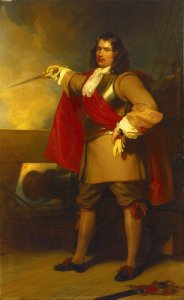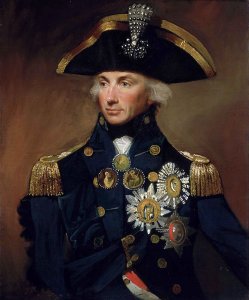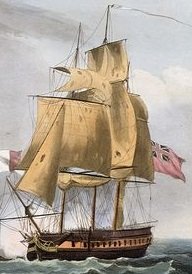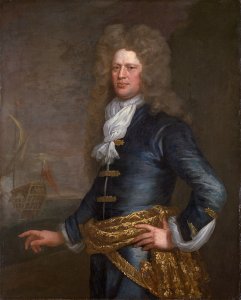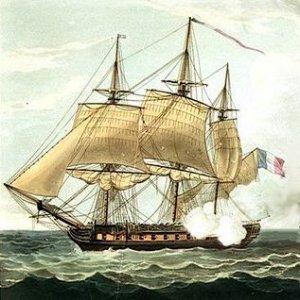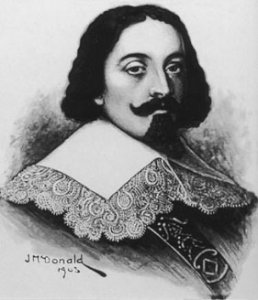Today in Naval History - Naval / Maritime Events in History
26th of September
please use the following link and you will find the details and all events of this day ..... in the following you will find some of the events
1580 – Sir Francis Drake finishes his circumnavigation of the Earth
Sir Francis Drake (c. 1540 – 28 January 1596) was an English sea captain, privateer, slave trader, naval officer and explorer of the Elizabethan era. Drake carried out the second circumnavigation of the world in a single expedition, from 1577 to 1580, and was the first to complete the voyage as captain while leading the expedition throughout the entire circumnavigation. With his incursion into the Pacific Ocean, he claimed what is now California for the English and inaugurated an era of conflict with the Spanish on the western coast of the Americas, an area that had previously been largely unexplored by western shipping.
Elizabeth I awarded Drake a knighthood in 1581 which he received on the Golden Hind in Deptford. As a Vice Admiral, he was second-in-command of the English fleet in the battle against the Spanish Armada in 1588. He died of dysentery in January 1596, after unsuccessfully attacking San Juan, Puerto Rico. Drake's exploits made him a hero to the English, but his privateering led the Spanish to brand him a pirate, known to them as El Draque. King Philip II allegedly offered a reward for his capture or death of 20,000 ducats, about £6 million (US$8 million) in modern currency.
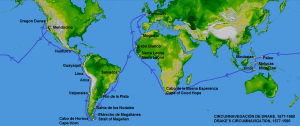
A map of Drake's route around the world. The northern limit of Drake's exploration of the Pacific coast of North America is still in dispute. Drake's Bay is south of Cape Mendocino.
1748 – Birth of Cuthbert Collingwood, 1st Baron Collingwood, English admiral (d. 1810)
Vice Admiral Cuthbert Collingwood, 1st Baron Collingwood (26 September 1748 – 7 March 1810) was an admiral of the Royal Navy, notable as a partner with Lord Nelson in several of the British victories of the Napoleonic Wars, and frequently as Nelson's successor in commands.
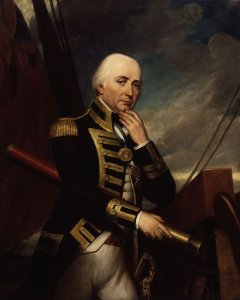
1771 - Launch of HMS Grafton, a 74 gun Albion-class Ship of the Line
HMS Grafton was a 74-gun third rate ship of the line of the Royal Navy, launched on 26 September 1771 at Deptford Dockyard.
In 1779 she fought at the head of the British line at the Battle of Grenada, and in 1780 she was part of Rodney's fleet at the Battle of Martinique.
From 1792 Grafton was on harbour service, and she was broken up in 1816.

1794 – Launch of French Forte, a 42 gun Forte-class frigate
Forte was a French 42-gun frigate, lead ship of her class.

Capture of 'La Forte', 28 February 1799 (PAD5620)

Plans of the French 24-pounder frigate Forte
1800 – Diligence-class Brig-Sloop HMS Hound (1796 - 16), William James Turquand, wrecked near Shetland.
HMS Hound was a brig-sloop of the Royal Navy. She had a short history. After her launch in 1796 she captured two privateers and destroyed a third before she was lost in 1800.

1805 - HMS Calcutta captured by french squadron
HMS Calcutta (50), Cptn. Daniel Woodriff, whilst escorting a convoy near the Scillies drew off a French squadron of a three-decker and four ships-of-the-line with frigates and other vessels. She was captured by French ship-of-the-line Magnanime and frigate Armide (44) but all the convoy except 1 ship made their escape.

The action of September 1805 in which the French captured HMS Calcutta, by Thomas Whitcombe
1810 - Launch of HMS Astraea, a 36 gun Apollo-class frigate
HMS Astraea (frequently spelled HMS Astrea) was a Royal Navy 36-gun fifth rate Apollo-class frigate, launched- in 1810 at Northam. She participated in the Battle of Tamatave and in an inconclusive single-ship action with the French frigate Etoile. Astrea was broken up in 1851.

Battle of Tamatave (Action of 20 May 1811)
1814 - The Battle of Fayal
Boats of HMS Plantagenet (74), Cptn. Robert Lloyd, and HMS Rota (38), Cptn. Somerville, covered by HMS Carnation (18), George Bentahm, repulsed by American privateer schooner General Armstrong, Cptn. Samuel C. Reid, at anchor in the road at Fayal in the Azores.
The Battle of Fayal was an engagement fought in September 1814 during the war between the United States and the United Kingdom at the Portuguese colony of Fayal in the Azores. Three British warships and several boats filled with sailors and marines under assignment for the Louisiana Campaign attacked an American privateer in port. After repulsing two attacks from British troops and sailors, killing one of their commanders, the Americans won a tactical victory but scuttled their ship the following morning to prevent it from being captured.

"The American Privateer General Armstrong Capt. Sam. C. Reid" by Nethaniel Currier, circa 1830.
1883 – SS Rotterdam (1872) , a dutch passenger ship ran aground and sunk
SS Rotterdam was a Dutch Passenger ship that ran aground and sunk on the Zeehondenbank near the Dutch island of Schouwen, while she was travelling from New York, United States to Rotterdam, The Netherlands.

1908 - Launch of SMS Rheinland
SMS Rheinland was one of four Nassau-class battleships, the first dreadnoughts built for the German Imperial Navy (Kaiserliche Marine). Rheinland mounted twelve 28 cm (11 in) main guns in six twin turrets in an unusual hexagonal arrangement. The navy built Rheinland and her sister ships in response to the revolutionary British HMS Dreadnought, which had been launched in 1906. Rheinland was laid down in June 1907, launched the following year in October, and commissioned in April 1910.

RHEINLAND (German battleship, 1908-1921) Caption: Photographed by Arthur Renard of Kiel, soon after the ship entered service on 30 April 1910.

The four Nassau class ships (bottom right) with the rest of the I Battle Squadron and the II Battle Squadron before the outbreak of war
1918 - Coast Guard cutter Tampa is steaming through the Bristol Channel when she is torpedoed and sunk by the German submarine UB-91.
All those on board, 115 crew members and 16 passengers, are killed, resulting in the greatest combat-related loss of life suffered by the U.S. Naval forces during WWI.
USCGC Tampa (ex-Miami) was a Miami-Class cutter that initially served in the U.S. Revenue Cutter Service, followed by service in the U.S. Coast Guard and the U.S. Navy. Tampa was used extensively on the International Ice Patrol and also during the Gasparilla Carnival at Tampa, Florida and other regattas as a patrol vessel. It was sunk with the highest American combat casualty loss in World War I.

Miami-class cutter USCGC Tampa photographed in harbour, prior to the First World War. Completed in 1912 as the U.S. Revenue Cutter Miami, this ship was renamed Tampa in February 1916. On 26 September 1918, while operating in the English Channel, she was torpedoed and sunk by the German Submarine UB-91. All 131 persons on board Tampa were lost with her, the largest loss of life on any U.S. combat vessel during the First World War.
1931 - The keel to USS Ranger (CV 4) is laid at Newport , Va. She is the first ship designed and constructed as an aircraft carrier.
, Va. She is the first ship designed and constructed as an aircraft carrier.
USS Ranger (CV-4) was the first ship of the United States Navy to be designed and built from the keel up as an aircraft carrier. Ranger was a relatively small ship, closer in size and displacement to the first US carrier—Langley—than later ships. An island superstructure was not included in the original design, but was added after completion. Deemed too slow for use with the Pacific Fleet's carrier task forces against Japan, the ship spent most of World War II in the Atlantic Ocean where the German fleet was a weaker opposition. Ranger saw combat in that theatre and provided air support for Operation Torch. In October 1943, she fought in Operation Leader, air attacks on German shipping off Norway. The ship was sold for scrap in 1947.

The U.S. Navy aircraft carrier USS Ranger (CV-4) underway at sea during the later 1930s.
1934 – Steamship RMS Queen Mary is launched.
The RMS Queen Mary is a retired British ocean liner that sailed primarily on the North Atlantic Ocean from 1936 to 1967 for the Cunard Line – known as Cunard-White Star Line when the vessel entered service. Built by John Brown & Company in Clydebank, Scotland, Queen Mary, along with RMS Queen Elizabeth, were built as part of Cunard's planned two-ship weekly express service between Southampton, Cherbourg and New York. The two ships were a British response to the express superliners built by German, Italian and French companies in the late 1920s and early 1930s. Queen Mary was the flagship of the Cunard Line from May 1936 until October 1946 when she was replaced in that role by Queen Elizabeth.

RMS Queen Mary in Long Beach, California
1954 – Japanese rail ferry Tōya Maru sinks during a typhoon in the Tsugaru Strait, Japan, killing 1,172.
Tōya Maru (洞爺丸) was a Japanese train ferry constructed by the Japanese National Railways which sank during a typhoon in the Tsugaru Strait between the Japanese islands of Hokkaidō and Honshū on September 26, 1954. The Japanese National Railways announced in September 1955 that 1,153 people aboard were killed in the accident. However, the exact number of fatalities remains unknown because there were victims who managed to obtain passage on the ship at the last minute, and others who cancelled their tickets just before the incident occurred.

Japanese ferry Toya Maru which was lost with 1,200 passengers and crew off Hokkaido, Japan on 26 September 1954.
2000 – The MS Express Samina sinks off Paros in the Aegean Sea killing 80 passengers.
MS Express Samina (Greek: Εξπρές Σαμίνα) was a French-built roll-on/roll-off (RORO) passenger ferry that collided with a reef off the coast of Paros island in the central Aegean Sea on 26 September 2000. The accident resulted in 81 deaths[3] and the loss of the ship. The cause of the accident was crew negligence, for which several members were found criminally liable.

The ferry Express Samina in Piraeus in July 2000.
2002 – An overcrowded Senegalese ferry, MV Le Joola, capsizes off the coast of the Gambia killing more than 1,800 people
MV Le Joola was a Senegalese government-owned roll-on/roll-off ferry that capsized off the coast of the Gambia on 26 September 2002,[1] with 1,863 deaths and 64 survivors. It is thought to be the second-worst non-military disaster in maritime history.
The ship was plying the route from Ziguinchor in the Casamance region to the Senegalese capital, Dakar, when it ran into a violent storm, farther out to sea than it was licensed to sail. The estimated 2000 passengers aboard (about half of whom lacked tickets) would have amounted to at least three times the ship's design capacity. The large numbers sleeping on-deck (and thus above its center of buoyancy) added further instability. Rescue operations did not start for several hours.
A government inquiry principally blamed negligence, and accusations were levelled at both the Senegalese president and prime minister.

MV Le Joola at Ziguinchor in 1991
26th of September
please use the following link and you will find the details and all events of this day ..... in the following you will find some of the events
Naval/Maritime History - 27th of August - Today in Naval History - Naval / Maritime Events in History
Today in Naval History - Naval / Maritime Events in History 25 September 1868 – The Imperial Russian steam frigate Alexander Nevsky is shipwrecked off Jutland while carrying Grand Duke Alexei Alexandrovich of Russia. Alexander Nevsky (Russian: Александр Невский) was a large screw frigate of...
shipsofscale.com
1580 – Sir Francis Drake finishes his circumnavigation of the Earth
Sir Francis Drake (c. 1540 – 28 January 1596) was an English sea captain, privateer, slave trader, naval officer and explorer of the Elizabethan era. Drake carried out the second circumnavigation of the world in a single expedition, from 1577 to 1580, and was the first to complete the voyage as captain while leading the expedition throughout the entire circumnavigation. With his incursion into the Pacific Ocean, he claimed what is now California for the English and inaugurated an era of conflict with the Spanish on the western coast of the Americas, an area that had previously been largely unexplored by western shipping.
Elizabeth I awarded Drake a knighthood in 1581 which he received on the Golden Hind in Deptford. As a Vice Admiral, he was second-in-command of the English fleet in the battle against the Spanish Armada in 1588. He died of dysentery in January 1596, after unsuccessfully attacking San Juan, Puerto Rico. Drake's exploits made him a hero to the English, but his privateering led the Spanish to brand him a pirate, known to them as El Draque. King Philip II allegedly offered a reward for his capture or death of 20,000 ducats, about £6 million (US$8 million) in modern currency.

A map of Drake's route around the world. The northern limit of Drake's exploration of the Pacific coast of North America is still in dispute. Drake's Bay is south of Cape Mendocino.
1748 – Birth of Cuthbert Collingwood, 1st Baron Collingwood, English admiral (d. 1810)
Vice Admiral Cuthbert Collingwood, 1st Baron Collingwood (26 September 1748 – 7 March 1810) was an admiral of the Royal Navy, notable as a partner with Lord Nelson in several of the British victories of the Napoleonic Wars, and frequently as Nelson's successor in commands.

1771 - Launch of HMS Grafton, a 74 gun Albion-class Ship of the Line
HMS Grafton was a 74-gun third rate ship of the line of the Royal Navy, launched on 26 September 1771 at Deptford Dockyard.
In 1779 she fought at the head of the British line at the Battle of Grenada, and in 1780 she was part of Rodney's fleet at the Battle of Martinique.
From 1792 Grafton was on harbour service, and she was broken up in 1816.
1794 – Launch of French Forte, a 42 gun Forte-class frigate
Forte was a French 42-gun frigate, lead ship of her class.
Capture of 'La Forte', 28 February 1799 (PAD5620)
Plans of the French 24-pounder frigate Forte
1800 – Diligence-class Brig-Sloop HMS Hound (1796 - 16), William James Turquand, wrecked near Shetland.
HMS Hound was a brig-sloop of the Royal Navy. She had a short history. After her launch in 1796 she captured two privateers and destroyed a third before she was lost in 1800.
1805 - HMS Calcutta captured by french squadron
HMS Calcutta (50), Cptn. Daniel Woodriff, whilst escorting a convoy near the Scillies drew off a French squadron of a three-decker and four ships-of-the-line with frigates and other vessels. She was captured by French ship-of-the-line Magnanime and frigate Armide (44) but all the convoy except 1 ship made their escape.
The action of September 1805 in which the French captured HMS Calcutta, by Thomas Whitcombe
1810 - Launch of HMS Astraea, a 36 gun Apollo-class frigate
HMS Astraea (frequently spelled HMS Astrea) was a Royal Navy 36-gun fifth rate Apollo-class frigate, launched- in 1810 at Northam. She participated in the Battle of Tamatave and in an inconclusive single-ship action with the French frigate Etoile. Astrea was broken up in 1851.
Battle of Tamatave (Action of 20 May 1811)
1814 - The Battle of Fayal
Boats of HMS Plantagenet (74), Cptn. Robert Lloyd, and HMS Rota (38), Cptn. Somerville, covered by HMS Carnation (18), George Bentahm, repulsed by American privateer schooner General Armstrong, Cptn. Samuel C. Reid, at anchor in the road at Fayal in the Azores.
The Battle of Fayal was an engagement fought in September 1814 during the war between the United States and the United Kingdom at the Portuguese colony of Fayal in the Azores. Three British warships and several boats filled with sailors and marines under assignment for the Louisiana Campaign attacked an American privateer in port. After repulsing two attacks from British troops and sailors, killing one of their commanders, the Americans won a tactical victory but scuttled their ship the following morning to prevent it from being captured.
"The American Privateer General Armstrong Capt. Sam. C. Reid" by Nethaniel Currier, circa 1830.
1883 – SS Rotterdam (1872) , a dutch passenger ship ran aground and sunk
SS Rotterdam was a Dutch Passenger ship that ran aground and sunk on the Zeehondenbank near the Dutch island of Schouwen, while she was travelling from New York, United States to Rotterdam, The Netherlands.
1908 - Launch of SMS Rheinland
SMS Rheinland was one of four Nassau-class battleships, the first dreadnoughts built for the German Imperial Navy (Kaiserliche Marine). Rheinland mounted twelve 28 cm (11 in) main guns in six twin turrets in an unusual hexagonal arrangement. The navy built Rheinland and her sister ships in response to the revolutionary British HMS Dreadnought, which had been launched in 1906. Rheinland was laid down in June 1907, launched the following year in October, and commissioned in April 1910.
RHEINLAND (German battleship, 1908-1921) Caption: Photographed by Arthur Renard of Kiel, soon after the ship entered service on 30 April 1910.
The four Nassau class ships (bottom right) with the rest of the I Battle Squadron and the II Battle Squadron before the outbreak of war
1918 - Coast Guard cutter Tampa is steaming through the Bristol Channel when she is torpedoed and sunk by the German submarine UB-91.
All those on board, 115 crew members and 16 passengers, are killed, resulting in the greatest combat-related loss of life suffered by the U.S. Naval forces during WWI.
USCGC Tampa (ex-Miami) was a Miami-Class cutter that initially served in the U.S. Revenue Cutter Service, followed by service in the U.S. Coast Guard and the U.S. Navy. Tampa was used extensively on the International Ice Patrol and also during the Gasparilla Carnival at Tampa, Florida and other regattas as a patrol vessel. It was sunk with the highest American combat casualty loss in World War I.
Miami-class cutter USCGC Tampa photographed in harbour, prior to the First World War. Completed in 1912 as the U.S. Revenue Cutter Miami, this ship was renamed Tampa in February 1916. On 26 September 1918, while operating in the English Channel, she was torpedoed and sunk by the German Submarine UB-91. All 131 persons on board Tampa were lost with her, the largest loss of life on any U.S. combat vessel during the First World War.
1931 - The keel to USS Ranger (CV 4) is laid at Newport
 , Va. She is the first ship designed and constructed as an aircraft carrier.
, Va. She is the first ship designed and constructed as an aircraft carrier.USS Ranger (CV-4) was the first ship of the United States Navy to be designed and built from the keel up as an aircraft carrier. Ranger was a relatively small ship, closer in size and displacement to the first US carrier—Langley—than later ships. An island superstructure was not included in the original design, but was added after completion. Deemed too slow for use with the Pacific Fleet's carrier task forces against Japan, the ship spent most of World War II in the Atlantic Ocean where the German fleet was a weaker opposition. Ranger saw combat in that theatre and provided air support for Operation Torch. In October 1943, she fought in Operation Leader, air attacks on German shipping off Norway. The ship was sold for scrap in 1947.
The U.S. Navy aircraft carrier USS Ranger (CV-4) underway at sea during the later 1930s.
1934 – Steamship RMS Queen Mary is launched.
The RMS Queen Mary is a retired British ocean liner that sailed primarily on the North Atlantic Ocean from 1936 to 1967 for the Cunard Line – known as Cunard-White Star Line when the vessel entered service. Built by John Brown & Company in Clydebank, Scotland, Queen Mary, along with RMS Queen Elizabeth, were built as part of Cunard's planned two-ship weekly express service between Southampton, Cherbourg and New York. The two ships were a British response to the express superliners built by German, Italian and French companies in the late 1920s and early 1930s. Queen Mary was the flagship of the Cunard Line from May 1936 until October 1946 when she was replaced in that role by Queen Elizabeth.
RMS Queen Mary in Long Beach, California
1954 – Japanese rail ferry Tōya Maru sinks during a typhoon in the Tsugaru Strait, Japan, killing 1,172.
Tōya Maru (洞爺丸) was a Japanese train ferry constructed by the Japanese National Railways which sank during a typhoon in the Tsugaru Strait between the Japanese islands of Hokkaidō and Honshū on September 26, 1954. The Japanese National Railways announced in September 1955 that 1,153 people aboard were killed in the accident. However, the exact number of fatalities remains unknown because there were victims who managed to obtain passage on the ship at the last minute, and others who cancelled their tickets just before the incident occurred.
Japanese ferry Toya Maru which was lost with 1,200 passengers and crew off Hokkaido, Japan on 26 September 1954.
2000 – The MS Express Samina sinks off Paros in the Aegean Sea killing 80 passengers.
MS Express Samina (Greek: Εξπρές Σαμίνα) was a French-built roll-on/roll-off (RORO) passenger ferry that collided with a reef off the coast of Paros island in the central Aegean Sea on 26 September 2000. The accident resulted in 81 deaths[3] and the loss of the ship. The cause of the accident was crew negligence, for which several members were found criminally liable.
The ferry Express Samina in Piraeus in July 2000.
2002 – An overcrowded Senegalese ferry, MV Le Joola, capsizes off the coast of the Gambia killing more than 1,800 people
MV Le Joola was a Senegalese government-owned roll-on/roll-off ferry that capsized off the coast of the Gambia on 26 September 2002,[1] with 1,863 deaths and 64 survivors. It is thought to be the second-worst non-military disaster in maritime history.
The ship was plying the route from Ziguinchor in the Casamance region to the Senegalese capital, Dakar, when it ran into a violent storm, farther out to sea than it was licensed to sail. The estimated 2000 passengers aboard (about half of whom lacked tickets) would have amounted to at least three times the ship's design capacity. The large numbers sleeping on-deck (and thus above its center of buoyancy) added further instability. Rescue operations did not start for several hours.
A government inquiry principally blamed negligence, and accusations were levelled at both the Senegalese president and prime minister.
MV Le Joola at Ziguinchor in 1991



